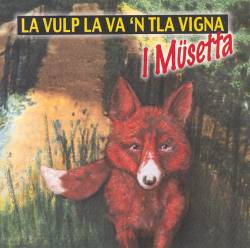 and followed their two earlier cassette recordings of the piffero / müsa duo, on the Madau Dischi and Robi Droli labels. All three were filled with splendid music.
and followed their two earlier cassette recordings of the piffero / müsa duo, on the Madau Dischi and Robi Droli labels. All three were filled with splendid music.
La vulp la va 'n tla vigna
Ethnosuoni ES 5315
Back in 1995, I organised two gigs (Towersey and Wadebridge festivals) for I Müsetta, a piffero / müsa / accordion trio from the quattro province area of northern Italy. Their first CD, Mond e Pais e Mond, had just come out - it was number ES 001 on the Ethnosuoni label,  and followed their two earlier cassette recordings of the piffero / müsa duo, on the Madau Dischi and Robi Droli labels. All three were filled with splendid music.
and followed their two earlier cassette recordings of the piffero / müsa duo, on the Madau Dischi and Robi Droli labels. All three were filled with splendid music.
The quattro province is a mountainous area situated where the four northern Italian provinces of Piemont, Liguria, Lombardy and Emillia Romagna join. The local culture is very interesting in that it has incorporated disparate elements of Piemontese, Ligurian, Emilliana and Lombard tradition into a cohesive whole. The dance music was mostly based around the piffero, müsa and accordion combination. I say 'was' because, until the revival of the 1970s, the piffero was almost extinct - not just here, but in the whole of northern Italy.
One man kept it alive, built the instruments and passed them and the basic tune repertoire on to the young revivalists who were beginning to show an interest in the traditional music of their area. That man was Ettore 'Bani' Losini - leader and piffero player with I Müsetta. Without Bani, bands like La Ciapa Rusa and Tre Martelli would certainly have sounded very different; Stefano Valla might have remained just a singer! His importance to the revival of traditional music in the whole of northern Italy is absolutely incalculable.
I Müsetta was started in 1970 with Bani Losini, on piffero and occasional vocals, and Attilio 'Tilion' Rocca on piano accordion; both being traditional performers. In 1988 they were joined by Pier Carlo Cardinali on müsa (bagpipes) and guitar. For occasional local gigs (and on the CD) they were also joined by Bani's wife, Maria Rosa Mulazzi, a great singer who had been a Padana rice-field worker in her youth, and still has some of the 'rice girls' repertoire and style.
Now - some eight years later - we have this new CD; the personnel are the same, and they have the assistance of several members of the Ethnosuoni team, as indeed they did on the previous CD. But, for some reason, the music seems to have lost something in the intervening years - its edge, its excitement. I can't really see why this has happened; all three main protagonists are still playing well - a considerable achievement in the case of Tilion, who must be in his mid-eighties by now. But it's clear that, here, the glorious humorous invention of his earlier playing is missing from many of the tracks. Bani sings more often than on the previous CD; and he's not always the greatest of singers, needing the key to be just right for him to give of his best. The lovely Maria Rosa had the whole of La bella riccoilina to herself on the previous CD; ![]() here she sings only on the choruses of two songs - but one is the final track, Guarda sulla collina, which features all four main participants, unaccompanied (sound clip). This is so good that it almost makes up for the rather lacklustre performances which precede it - but not quite.
here she sings only on the choruses of two songs - but one is the final track, Guarda sulla collina, which features all four main participants, unaccompanied (sound clip). This is so good that it almost makes up for the rather lacklustre performances which precede it - but not quite.
In hopes that Ethnosuoni ES 001 - I Müsetta: Mond e Pais e Mond is still available, I'd strongly recommend that as your first purchace from www.folkclubethnosuoni.com
Rod Stradling - 29.3.03
| Top | Home Page | MT Records | Articles | Reviews | News | Editorial | Map |